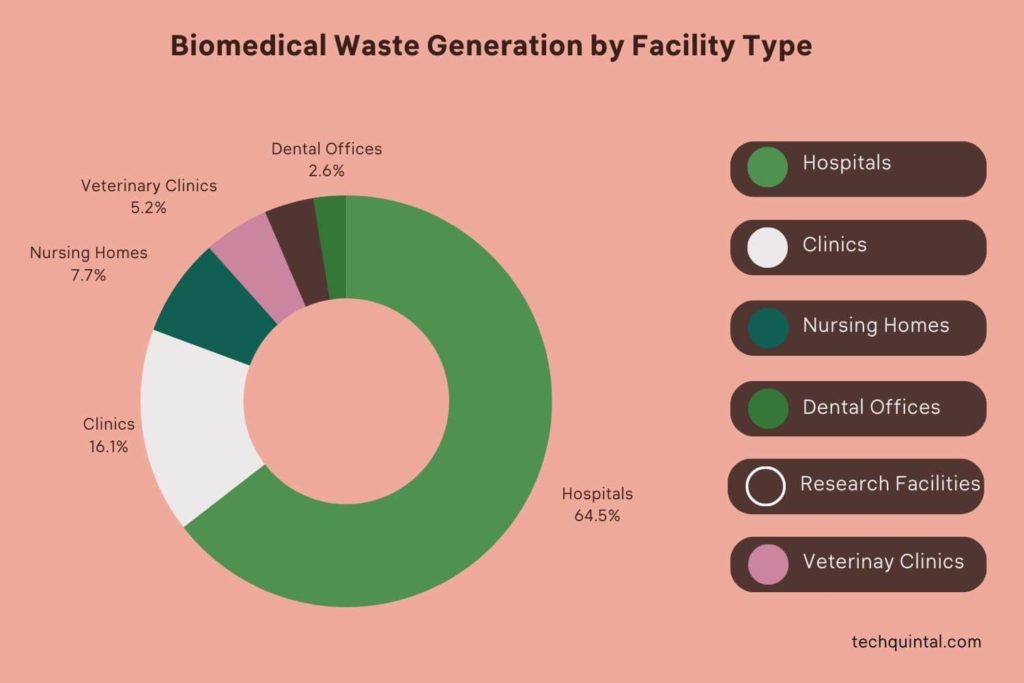
Biomedical waste, also known as hospital waste, is any type of waste created during the diagnosis, treatment (therapy, surgery, medication, etc.), immunization of humans or animals, medical research activities, or manufacturing and testing biologicals. It requires a careful approach and must be disposed of under strict guidelines, because it is, has the potential to, and is presumed to be infectious. As such, it’s obvious who produces the vast majority of the waste – hospitals, health clinics, doctor’s offices, nursing homes, research laboratories, morgues, and funeral homes, etc. With that, let’s dive straight into modern technology for handling biomedical waste.
Quick Answer for How Modern Technology is Used for Handling Biomedical Waste
Modern technology has revolutionized biomedical waste management by employing methods such as autoclaving, incineration, and microwave treatment to sterilize or destroy the waste. Digital tracking systems are used for waste classification, ensuring regulatory compliance and efficient handling throughout the disposal process.
Furthermore, advanced recycling technologies are increasingly adopted, transforming certain types of biomedical waste into reusable materials to promote sustainability.
Types of Biomedical Waste
| Type of Biomedical Waste | Description | Composition (Example) |
|---|---|---|
| Infectious Waste | Waste that may harbor pathogens and infectious agents | Used bandages, cultures, sharps |
| Pathological Waste | Containing tissues, organs, or body parts | Amputated limbs, biopsy samples |
| Sharps Waste | Items that can puncture or lacerate, such as needles | Hypodermic needles, scalpels |
| Pharmaceutical Waste | Expired or unused medications | Expired antibiotics, chemotherapy |
| Radioactive Waste | Waste contaminated with radioactive materials | Radioactive isotopes, protective gear |
| Chemical Waste | Waste containing hazardous chemicals | Disinfectants, solvents, mercury |
| General Healthcare Waste | Non-hazardous waste generated in healthcare settings | Paper, cardboard, non-infectious materials |
1. Biomedical waste minimization

Although not a subject of major technological improvements throughout the years, minimizing biomedical waste production is a key part of our clean future. The primary obstacle is that personnel must presume the waste is infectious even if signs or experience say otherwise.
The risks of contamination are simply too significant. Facilities are fighting this by introducing smart or automated inventory systems that use QR codes, bar codes, RFID chips, or other means of identification.
Moreover, they’re investing in improved recycling processes, especially of plastic, glass, and stainless steel, as well as on-site, even portable cleaning and disinfection apparatus.
2. Biomedical waste segregation
Waste segregation systems are the next example of modern technology for handling biomedical waste. The system takes care of identification, quantification, and proper sorting. Without it, or with an improper application, waste can have disastrous consequences on nature, people, and animals.
Besides a high risk of transmitting diseases to humans, especially HIV, hepatitis B, and hepatitis C, inadequately stored waste can also disseminate various forms of bacteria, viruses, chemicals, and radioactive materials.
Alongside humans, the primary spreaders are stray animals, birds, and rodents. Besides digital systems for separation, organization, time management, and shipping, technology plays a part in the protection, recycling, and reuse of storage containers, where possible.
How is hospital waste separated?
For decades, the containers for different types of waste are color-coded (red, yellow, blue, white/transparent, and black). While their appearance hasn’t changed significantly, their production cost, leak-proof capabilities, and sturdiness were improved through the benefits of globalization. Some examples include:
- Puncture-proof containers (sharps)
- Sturdy plastic or Ziploc bags (solids, liquids, animal anatomic parts, smaller medical equipment)
- Biohazard fiber drums (larger anatomical parts)
- Biohazard boxes (solids, cell cultures, dull medical equipment, supplies)
- Fume funnels (toxic, chemical, and air-polluting waste)
3. Waste disposal (treatment)
The objective of treating biomedical waste is to dispose of it safely, efficiently, and affordably. Obviously, different waste requires distinct methods and for some types of waste, the eradication begins on-site. However, it always finishes off-site. Here are a few modern technology methods for handling biomedical waste and its destruction:
Autoclaving
Autoclaving, more precisely, steam sterilization, is a process of waste destruction via extremely hot, high-pressure steam, which remains active for a specified time. To improve efficiency, professionals often shredded, mill, and crush the waste beforehand. That way, the steam can kill close to 100% of microorganisms.
This makes it suitable for nearly all waste, except anatomical, pharmaceutical, and chemical ones. It’s affordable, relatively quick, and poses no health or environmental risks. However, it doesn’t reduce the volume of the waste, which ends on a landfill alongside regular waste.
Chemical disinfection
Most people are familiar with two forms of chemical disinfection. The first is bleach, used in solutions of 1% to 10%, limited to liquids and waste in small quantities. The other is chlorine, used in swimming pools and tap water. For more intricate and larger waste, machines deploy alkali disinfectants such as sodium hydroxide, lye, quicklime, and calcium oxide.
While effective for hospitals and non-anatomic waste, it’s inadequate for anatomic and some chemical and pharmaceutical waste. Additionally, ozone gas, used for sterilization, is destructive to our lungs, while alkalis are highly corrosive to both lungs and skin.
Incineration
Incineration used to be the most popular method for eradicating all biological or medical waste and up to 99% of microorganisms. As the same suggests, incinerators are machines that use immense heat to “cremate” waste, only leaving ash, soot, and slag. While extremely effective, the machine is very expensive to build and operate.
Furthermore, it pollutes the atmosphere via smoke, ash, toxic gas, odor, and, if it malfunctions, extremely hot exhaust air. It’s also ineffective at eradicating cytotoxic, waste, and thermally-resistant chemicals.
Microwaving
Current microwave generators (2+ are almost always in use) operate at a wavelength of 12.24 cm and a frequency of roughly 2450 MHz. They combine rapid heating of the liquid in the waste with the heat conduction of the infectious elements to dispose of it. To boost the efficiency of the procedure, waste is usually first shredded, and then humidified. Because the waste is harmless in the end, operators can dump it in a regular waste stream.
Unfortunately, it has a high operating and investment price and doesn’t work on metal. Additionally, not all countries approve of it because the long-term hazards of microwaves aren’t crystal clear. Experts seek to solve those problems with upcoming technologies, one of which uses electron beams.
Shredding
We mentioned shredding a few times as a precursor to other methods, which is its primary purpose. Two knife blocks, horizontal and vertical, shred the waste into tiny pieces, reducing their volume by between 70% and 80%, and increasing the contact surface with the disinfectant. It also turns human and animal body parts unidentifiable, removing the chance of adverse visual effects.
Inertization
Inertization is the last resort option, used when no other technology for biomedical waste handling works. Professionals in the field also use it when remnants of other techniques, especially incineration ash, chemicals, and pharmaceutical products, risk affecting the environment or contain a lot of metal.
In essence, they crush biomedical waste into a homogenous mass, mix it with water, cement, and lime, and shape it into blocks, commonly measuring 1 cubic meter/35.3 cubic feet. While still liquid, the personnel can sort the resulting mass with municipal waste. Alternatively, they can wait for it to harden before transporting it to a regular landfill. This method is inexpensive, doesn’t require special equipment nor expertise, and uses a centuries-old recipe.
Emerging Technologies in Biomedical Waste Management
If we look at the biomedical waste management industry, we will find that certain steps have already been taken to ensure an increase in efficiency. And thanks to technological advancements, the biomedical waste management industry has also started adopting new methods to deal with waste. Especially after COVID-19, which exacerbated the need for an efficient biomedical waste removal process.
But even with all this, some countries are still facing a steep climb when it comes to handling biomedical waste. Take India, for example. The 2020 Central Pollution Control Board annual report stated that the country was generating around 620 tons of biowaste per day. However, it was only disposing of about 544 tons of waste as per the regulations.
Biomedical waste can’t be handled at a whim, as there is proper procedure and technique involved. Look at the following video that talks about handling liquid medical waste appropriately.
Here are some of the latest trends in biomedical waste management:
1. Thermal processes
As the name suggests, this process involves the use of heat to disinfect and dispose of biomedical waste. There are two methods that fall under it:
- Low-heat systems – A system that utilizes steam, hot water, or electromagnetic radiation between 93 and 177 °C to decontaminate biomedical waste. Autoclave and microwave technologies are examples of low-heat systems.
- High-heat systems – Uses combustion to destroy and distill biomedical waste. Incinerators and Hydroclaving systems are technologies that use high heat.
2. Plasma Gasification
Still in its emerging phase, plasma gasification holds potential. By using an oxygen-starved reactor, biomedical waste is broken down into hydrogen, carbon monoxide, and water, using high temperatures. It synergizes well with energy-generating plants that can produce heat, electricity, and liquid fuel.
3. Mechanical Processes
It mainly involves changing the physical components of the waste to facilitate waste handling and treatment much better. The main technologies that showcase this are compaction and shredding.
4. Irradiation Processes
Here, waste is exposed to ultraviolet or ionizing radiation. However, irradiation requires mechanical processes for the best results.
5. Biological Processes
Natural breakdown of biomedical waste by treating it with biological enzymes for decontamination and destruction of any organic component. It is much more in line with the green initiative as it adds no extra burden to nature.
Here is a table comparing all the different methods and technologies used in handling biomedical waste:
| Technology | Description | Benefits |
|---|---|---|
| Incineration | Using high temperatures, biomedical waste is reduced to waste | The most commonly used method that has been proven effective |
| Autoclaving | It uses steam and subjects it to high pressure and low heat to disinfect it. | It sterilizes waste and helps with volume control. |
| Chemical Processes | Introduce chemicals to boost natural decomposition | Sustainable and has much less impact on nature |
| Shredding | Destroying waste into smaller components using mechanical processes | Helps with reducing volume and allows methods like a landfill to be efficient |
| Microwave | Employs microwave radiation to treat biomedical waste | Most effective for small volumes |
| Plasma Gasification | By using an oxygen-free chamber, it breaks down waste into energy sources | Helps with energy production and reduces emission problems. |